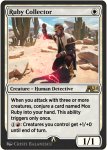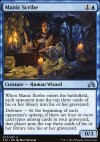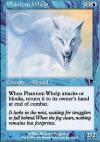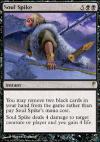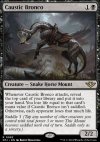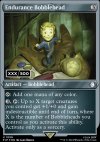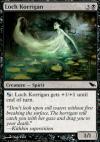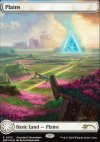|

MV anecdotes
| 966 anecdotes trouvées |   |
Les cinq cartes Ruby Collector, Emerald Collector, Pearl Collector, Sapphire Collector et Jet Collector, de l'édition Alchemy: Thunder Junction, forment un cycle appelé "Collector" et dont les noms et capacités déclenchées font référence aux cinq Moxen (voir cette anecdote).
Les trois cartes Lurking Evil, Lurking Skirge et Lurking Jackals forment un cycle du bloc des éditions Urza's Saga, Urza's Legacy et Urza's Destiny, ayant en commun le fait d'être un enchantement qui devient une créature lorsqu'une condition est remplie ou qu'un coût est payé.
Des cycles similaires existent au sein du même bloc (voir cette anecdote, celle-ci et celle-là).
Des cycles similaires existent au sein du même bloc (voir cette anecdote, celle-ci et celle-là).
Les cinq cartes Archery Training, Private Research, Festering Wound, Incendiary et Momentum, de l'édition Urza's Destiny, forment un cycle.
Source (Archery Training, Private Research, Festering Wound, Incendiary, and Momentum)
Source (Archery Training, Private Research, Festering Wound, Incendiary, and Momentum)
Les cinq cartes Serra's Hymn, Lilting Refrain, Vile Requiem, Torch Song et War Dance, ainsi que les cinq cartes Serra's Liturgy, Recantation, Discordant Dirge, Rumbling Crescendo et Midsummer Revel, de l'édition Urza's Saga, forment un cycle.
Source (Archery Training, Private Research, Festering Wound, Incendiary, and Momentum - "Urza's Saga had an uncommon cycle and a rare cycle of verse enchantment. [...]")
Source (Archery Training, Private Research, Festering Wound, Incendiary, and Momentum - "Urza's Saga had an uncommon cycle and a rare cycle of verse enchantment. [...]")
Les cinq cartes Niveous Wisps, Cerulean Wisps, Aphotic Wisps, Crimson Wisps et Viridescent Wisps, de l'édition Shadowmoor et illustrées par Jim Nelson, forment un cycle appelé "Wisps".
Les cinq cartes Apothecary Initiate, Drowner Initiate, Smolder Initiate, Intimidator Initiate et Nurturer Initiate, de l'édition Shadowmoor, forment un cycle appelé "Initiate".
Les cinq cartes Topplegeist, Manic Scribe, Tooth Collector, Gibbering Fiend et Obsessive Skinner, de l'édition Shadows over Innistrad, forment un cycle de créatures avec une capacité déclenchée d'arrivée qui se reproduit au début de l'entretien de chaque adversaire si la condition du Délire est remplie.
Les cinq cartes Kithkin Zealot, Wilderness Hypnotist, Talara's Bane, Chaotic Backlash et Marshdrinker Giant, de l'édition Eventide, forment un cycle de "Color-Hosers".
Les cinq cartes Patrol Hound, Phantom Whelp, Filthy Cur, Mad Dog et Wild Mongrel, de l'édition Odyssey, forment un cycle de chiens.
Source ("[...] until Erik Lauer joined R&D. I knew for a fact that Erik Lauer loved dogs. In Odyssey, I'd made a cycle of dogs specifically for Erik (at Randy Buehler's request—Randy and Erik are old friends).")
Source ("[...] until Erik Lauer joined R&D. I knew for a fact that Erik Lauer loved dogs. In Odyssey, I'd made a cycle of dogs specifically for Erik (at Randy Buehler's request—Randy and Erik are old friends).")
Les cinq cartes Sunscour, Commandeer, Soul Spike, Fury of the Horde et Allosaurus Rider, de l'édition Coldsnap, forment un cycle.
Les cinq cartes Rakdos Joins Up, Vraska Joins Up, Kellan Joins Up, Annie Joins Up et Tinybones Joins Up, de l'édition Outlaws of Thunder Junction et illustrées par Wylie Beckert, forment un cycle appelé "- Joins Up" d'enchantements légendaires correspondant au moment où les personnages Rakdos, the Muscle, Vraska, the Silencer, Kellan, the Kid, Annie Flash, the Veteran et Tinybones, the Pickpocket rejoignent la bande de Oko, the Ringleader (voir cette anecdote).
Les deux cartes Archmage's Newt et Caustic Bronco forment une paire de créatures avec la capacité mot-clé Seller et ayant une capacité déclenchée pendant l'étape de combat, dont l'effet est renforcé lorsque la créature attaque en étant sellée.
Les dix cartes Wrangler of the Damned, Intimidation Campaign, At Knifepoint, Cactusfolk Sureshot, Congregation Gryff, Ruthless Lawbringer, Slick Sequence, Badlands Revival, Form a Posse et Make Your Own Luck, ainsi que les dix cartes Jem Lightfoote, Sky Explorer, Lazav, Familiar Stranger, Vial Smasher, Gleeful Grenadier, Jolene, Plundering Pugilist, Miriam, Herd Whisperer, Baron Bertram Graywater, Kraum, Violent Cacophony, Honest Rutstein, Ertha Jo, Frontier Mentor et Doc Aurlock, Grizzled Genius, de l'édition Outlaws of Thunder Junction, forment un cycle de sorts bicolores peu communs soutenant chacun un archétype de formats limités, ainsi qu'un cycle de créatures légendaires avec la même intention.
Source ("Draft, as an example, had a big influence on the uncommon gold cards that model Draft archetypes")
Source ("Draft, as an example, had a big influence on the uncommon gold cards that model Draft archetypes")
Citation :
WU Take a Break
Keep your guard up. Use the plot mechanic and cards with flash to pass your turn with mana available, ready for anything.
UB Crimes
Keep targeting your opponents and their stuff turn after turn. You're looking to play a long game, but your constant heists will leave your opponents less than prepared.
BR Outlaws
Assemble a crew of Assassins, Mercenaries, Pirates, Rogues, and Warlocks. This motley crew of outlaws will find ways to work together to wear down your opponents.
RG Power 4+
Big creatures are usually their own reward, but this set steps it up. Boost your forces with spells or Mercenary tokens and let the onslaught begin.
GW Mount
There's a whole stable of Mounts eager to charge into battle. Every time a Mount attacks backed by some skilled riders, you'll reap more rewards. Saddle up!
WB Attrition
Your permanents are here for a good time, not a long time. Sacrifice shamelessly, block fearlessly, and attack aggressively. Every loss is another opportunity for a larger gain.
UR Second Spell
Sling your spells in one-two bursts. Low mana value cards and plotted cards enable combinations of two or more spells in a turn, unlocking a flurry of bonuses.
BG Creatures in the Graveyard
You only live once? Hardly. Your cards can bring fallen creatures back to the fray or simply take advantage of
the number of creature cards in your graveyard.
RW Mercenary Aggro
You might not have the biggest creatures, but you have the most aggressive ones. Mercenary tokens will pump the
power of your creatures so you can keep making good attacks when opposition arrives.
GU Plot
Set your mastermind plans into motion with the plot mechanic. Your opponents may see them coming but that doesn't mean they'll be able to stop them. Control the battlefield and strike when the time is right.
Keep your guard up. Use the plot mechanic and cards with flash to pass your turn with mana available, ready for anything.
UB Crimes
Keep targeting your opponents and their stuff turn after turn. You're looking to play a long game, but your constant heists will leave your opponents less than prepared.
BR Outlaws
Assemble a crew of Assassins, Mercenaries, Pirates, Rogues, and Warlocks. This motley crew of outlaws will find ways to work together to wear down your opponents.
RG Power 4+
Big creatures are usually their own reward, but this set steps it up. Boost your forces with spells or Mercenary tokens and let the onslaught begin.
GW Mount
There's a whole stable of Mounts eager to charge into battle. Every time a Mount attacks backed by some skilled riders, you'll reap more rewards. Saddle up!
WB Attrition
Your permanents are here for a good time, not a long time. Sacrifice shamelessly, block fearlessly, and attack aggressively. Every loss is another opportunity for a larger gain.
UR Second Spell
Sling your spells in one-two bursts. Low mana value cards and plotted cards enable combinations of two or more spells in a turn, unlocking a flurry of bonuses.
BG Creatures in the Graveyard
You only live once? Hardly. Your cards can bring fallen creatures back to the fray or simply take advantage of
the number of creature cards in your graveyard.
RW Mercenary Aggro
You might not have the biggest creatures, but you have the most aggressive ones. Mercenary tokens will pump the
power of your creatures so you can keep making good attacks when opposition arrives.
GU Plot
Set your mastermind plans into motion with the plot mechanic. Your opponents may see them coming but that doesn't mean they'll be able to stop them. Control the battlefield and strike when the time is right.
Les dix cartes Lonely Arroyo, Soured Springs, Jagged Barrens, Bristling Backwoods, Creosote Heath, Forlorn Flats, Eroded Canyon, Festering Gulch, Abraded Bluffs et Lush Oasis, de l'édition Outlaws of Thunder Junction, forment un cycle de terrains. De plus leurs textes d'ambiance se font écho.
Ce cycle est inspiré de la carte Sunscorched Desert.
Ce cycle est inspiré de la carte Sunscorched Desert.
Les cinq cartes Flare of Fortitude, Flare of Denial, Flare of Malice, Flare of Duplication et Flare of Cultivation, de l'édition Modern Horizons III, forment un cycle appelé "Flare".
Chacune d'entre elles est une référence respectivement à Teferi's Protection (empruntant à Heroic Intervention), Counterspell, Soul Shatter, Reverberate et Cultivate de par leur effet.
Chacune d'entre elles est une référence respectivement à Teferi's Protection (empruntant à Heroic Intervention), Counterspell, Soul Shatter, Reverberate et Cultivate de par leur effet.
La carte Sword of Wealth and Power est une référence aux cycles appelés "Sword of this and that" (voir cette anecdote et celle-ci).
Elle semble être la première d'un nouveau cycle se focalisant cette fois sur les types de carte et non plus les couleurs.
Elle semble être la première d'un nouveau cycle se focalisant cette fois sur les types de carte et non plus les couleurs.
Les cinq cartes Scrutiny of the Guildpact, Mapping the Maze, Lurking Spinecrawler, Construction Arsonist et Guildpact Greenwalker, de l'édition Alchemy: Karlov Manor, forment un cycle.
Les sept cartes Strength Bobblehead, Perception Bobblehead, Endurance Bobblehead, Charisma Bobblehead, Intelligence Bobblehead, Agility Bobblehead et Luck Bobblehead, de l'édition Fallout, forment un cycle appelé "Bobblehead" d'artefacts, chacun correspondant à une figurine Bobblehead du jeu vidéo Fallout 3, permettant de modifier l'une des sept statistiques primaires, dont l'abréviation dans cet ordre forme l'acronyme S.P.E.C.I.A.L. .
Les sept cartes Steelshaper's Gift, Propaganda, Elixir of Immortality, Council's Judgment, Idyllic Tutor, Anger et Lightning Bolt, de l'édition Secret Lair - Fallout: S.P.E.C.I.A.L. et illustrées par Desmuncubic, font également référence à ces sept statistiques primaires de par l'initiale de leur nom anglais, leur illustration et leur texte d'ambiance. De plus sur chacune de leurs illustrations (excepté pour la première), un élément sur la gauche en rappelle un sur la droite de celle de la précédente carte.
Source (fandom ENG - avec spoilers éventuels)
Les sept cartes Steelshaper's Gift, Propaganda, Elixir of Immortality, Council's Judgment, Idyllic Tutor, Anger et Lightning Bolt, de l'édition Secret Lair - Fallout: S.P.E.C.I.A.L. et illustrées par Desmuncubic, font également référence à ces sept statistiques primaires de par l'initiale de leur nom anglais, leur illustration et leur texte d'ambiance. De plus sur chacune de leurs illustrations (excepté pour la première), un élément sur la gauche en rappelle un sur la droite de celle de la précédente carte.
Source (fandom ENG - avec spoilers éventuels)
Les cinq cartes Skycloud Expanse, Darkwater Catacombs, Shadowblood Ridge, Mossfire Valley et Sungrass Prairie, de l'édition Odyssey, ainsi que les cinq cartes Desolate Mire, Ferrous Lake, Viridescent Bog, Sunscorched Divide et Overflowing Basin, de l'édition Fallout, forment un cycle de terrains appelé "Filterlands".
Source ("Next is a land cycle. Design's version of this cycle is similar to what was printed with one key difference: these lands let you sacrifice the land to add one of the two colors of mana and draw a card. We included it to support threshold as much as we could. [...] In the end, the lands were too good with that ability and the set didn't need the extra sacrifice, so it was removed during development.")
Source ("Next is a land cycle. Design's version of this cycle is similar to what was printed with one key difference: these lands let you sacrifice the land to add one of the two colors of mana and draw a card. We included it to support threshold as much as we could. [...] In the end, the lands were too good with that ability and the set didn't need the extra sacrifice, so it was removed during development.")
Les dix-sept cartes The First Doctor, The Second Doctor, The Third Doctor, The Fourth Doctor, The Fifth Doctor, The Sixth Doctor, The Seventh Doctor, The Eighth Doctor, The War Doctor, The Ninth Doctor, The Tenth Doctor, The Eleventh Doctor, The Twelfth Doctor, The Thirteenth Doctor, The Fugitive Doctor, The Fourteenth Doctor et The Fifteenth Doctor, des éditions Doctor Who et Secret Lair - Doctor Who: Regeneration, forment un cycle appelé "Doctor" de créatures légendaires représentant les docteurs de la série TV Doctor Who ; la numérotation de 1 à 15 correspond aux différentes réincarnations du docteur au fil des saisons.
Ce sont les seules créatures du jeu possédant les deux types time lord (non traduit) et docteur.
Source : Le Docteur (fandom FR - avec spoilers éventuels) - Search ~ Créature + Type = time lord docteur
Ce sont les seules créatures du jeu possédant les deux types time lord (non traduit) et docteur.
Source : Le Docteur (fandom FR - avec spoilers éventuels) - Search ~ Créature + Type = time lord docteur
Les cinq cartes Rune-Cervin Rider, Parapet Watchers, Loch Korrigan, Blistering Dieflyn et Foxfire Oak, de l'édition Shadowmoor, forment un cycle.
Source (Shadowmoor Block - "[monocolor cards with hybrid activations] were on a cycle of commons, and one of the colors in the hybrid symbol matched the color of the card. The activations all pumped power and/or toughness, meaning you would want to activate them multiple times each turn if able. [...]")
Source (Shadowmoor Block - "[monocolor cards with hybrid activations] were on a cycle of commons, and one of the colors in the hybrid symbol matched the color of the card. The activations all pumped power and/or toughness, meaning you would want to activate them multiple times each turn if able. [...]")
Les cinq cartes Oteclan Landmark, Inverted Iceberg, Tithing Blade, Idol of the Deep King et Kaslem's Stonetree, de l'édition The Lost Caverns of Ixalan, forment un cycle d'artefacts communs avec une capacité déclenchée d'arrivée, ainsi que la capacité "Façonner".
Les cinq cartes Plains, Island, Swamp, Mountain et Forest, de l'édition Misc. Promos - "Standard Showdown 2024", forment un cycle de terrains appelé "Omenpath Basic Lands".
Source (Standard Showdown (February 9 – April 11, 2024) - "For the rest of the season, you'll provide your top performers at Standard Showdown with Omenpath Basic Lands. The Omenpath Basic Lands will be full-art, traditional foil cards that showcase how some of our heroes have been traversing the planes of the Multiverse.")
Source (Standard Showdown (February 9 – April 11, 2024) - "For the rest of the season, you'll provide your top performers at Standard Showdown with Omenpath Basic Lands. The Omenpath Basic Lands will be full-art, traditional foil cards that showcase how some of our heroes have been traversing the planes of the Multiverse.")
| 966 anecdotes trouvées |   |






 Spider-Man / Omenpaths
Spider-Man / Omenpaths Edge of Eternities
Edge of Eternities Final Fantasy
Final Fantasy Tarkir: Dragonstorm
Tarkir: Dragonstorm Aetherdrift
Aetherdrift Foundations
Foundations Duskmourn
Duskmourn